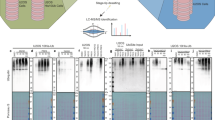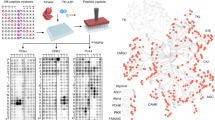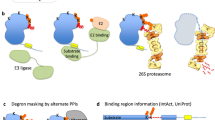Abstract
Cross-talk between different types of post-translational modifications on the same protein molecule adds specificity and combinatorial logic to signal processing, but it has not been characterized on a large-scale basis. We developed two methods to identify protein isoforms that are both phosphorylated and ubiquitylated in the yeast Saccharomyces cerevisiae, identifying 466 proteins with 2,100 phosphorylation sites co-occurring with 2,189 ubiquitylation sites. We applied these methods quantitatively to identify phosphorylation sites that regulate protein degradation via the ubiquitin-proteasome system. Our results demonstrate that distinct phosphorylation sites are often used in conjunction with ubiquitylation and that these sites are more highly conserved than the entire set of phosphorylation sites. Finally, we investigated how the phosphorylation machinery can be regulated by ubiquitylation. We found evidence for novel regulatory mechanisms of kinases and 14-3-3 scaffold proteins via proteasome-independent ubiquitylation.
This is a preview of subscription content, access via your institution
Access options
Subscribe to this journal
Receive 12 print issues and online access
$259.00 per year
only $21.58 per issue
Buy this article
- Purchase on SpringerLink
- Instant access to full article PDF
Prices may be subject to local taxes which are calculated during checkout




Similar content being viewed by others
References
Jenuwein, T. & Allis, C.D. Translating the histone code. Science 293, 1074–1080 (2001).
Hunter, T. The age of crosstalk: phosphorylation, ubiquitination, and beyond. Mol. Cell 28, 730–738 (2007).
Ichimura, T. et al. 14-3-3 proteins modulate the expression of epithelial Na+ channels by phosphorylation-dependent interaction with Nedd4-2 ubiquitin ligase. J. Biol. Chem. 280, 13187–13194 (2005).
Khosravi, R. et al. Rapid ATM-dependent phosphorylation of MDM2 precedes p53 accumulation in response to DNA damage. Proc. Natl. Acad. Sci. USA 96, 14973–14977 (1999).
Emanuele, M.J. et al. Global identification of modular cullin-RING ligase substrates. Cell 147, 459–474 (2011).
Kim, W. et al. Systematic and quantitative assessment of the ubiquitin-modified proteome. Mol. Cell 44, 325–340 (2011).
Wagner, S.A. et al. A proteome-wide, quantitative survey of in vivo ubiquitylation sites reveals widespread regulatory roles. Mol. Cell Proteomics 10, M111.013284 (2011).
Olsen, J.V. et al. Quantitative phosphoproteomics reveals widespread full phosphorylation site occupancy during mitosis. Sci. Signal. 3, ra3 (2010).
Huttlin, E.L. et al. A tissue-specific atlas of mouse protein phosphorylation and expression. Cell 143, 1174–1189 (2010).
van Noort, V. et al. Cross-talk between phosphorylation and lysine acetylation in a genome-reduced bacterium. Mol. Syst. Biol. 8, 571 (2012).
Yao, Q., Li, H., Liu, B.Q., Huang, X.Y. & Guo, L. SUMOylation-regulated protein phosphorylation, evidence from quantitative phosphoproteomics analyses. J. Biol. Chem. 286, 27342–27349 (2011).
Beltrao, P. et al. Systematic functional prioritization of protein posttranslational modifications. Cell 150, 413–425 (2012).
Peng, J. et al. A proteomics approach to understanding protein ubiquitination. Nat. Biotechnol. 21, 921–926 (2003).
Beausoleil, S.A. et al. Large-scale characterization of HeLa cell nuclear phosphoproteins. Proc. Natl. Acad. Sci. USA 101, 12130–12135 (2004).
Gauci, S. et al. Lys-N and trypsin cover complementary parts of the phosphoproteome in a refined SCX-based approach. Anal. Chem. 81, 4493–4501 (2009).
Nguyen Ba, A.N. & Moses, A.M. Evolution of characterized phosphorylation sites in budding yeast. Mol. Biol. Evol. 27, 2027–2037 (2010).
Landry, C.R., Levy, E.D. & Michnick, S.W. Weak functional constraints on phosphoproteomes. Trends Genet. 25, 193–197 (2009).
Kõivomägi, M. et al. Cascades of multisite phosphorylation control Sic1 destruction at the onset of S phase. Nature 480, 128–131 (2011).
Nash, P. et al. Multisite phosphorylation of a CDK inhibitor sets a threshold for the onset of DNA replication. Nature 414, 514–521 (2001).
Henchoz, S. et al. Phosphorylation- and ubiquitin-dependent degradation of the cyclin-dependent kinase inhibitor Far1p in budding yeast. Genes Dev. 11, 3046–3060 (1997).
Sia, R.A.L., Bardes, E.S.G. & Lew, D.J. Control of Swe1p degradation by the morphogenesis checkpoint. EMBO J. 17, 6678–6688 (1998).
Belle, A. Quantification of protein half-lives in the budding yeast proteome. Proc. Natl. Acad. Sci. USA 103, 13004–13009 (2006).
Liu, Q. et al. SCFCdc4 enables mating type switching in yeast by cyclin-dependent kinase-mediated elimination of the Ash1 transcriptional repressor. Mol. Cell Biol. 31, 584–598 (2011).
Kaplun, L., Ivantsiv, Y., Bakhrat, A. & Raveh, D. DNA damage response-mediated degradation of Ho endonuclease via the ubiquitin system involves its nuclear export. J. Biol. Chem. 278, 48727–48734 (2003).
Kishi, T., Ikeda, A., Koyama, N., Fukada, J. & Nagao, R. A refined two-hybrid system reveals that SCFCdc4-dependent degradation of Swi5 contributes to the regulatory mechanism of S-phase entry. Proc. Natl. Acad. Sci. USA 105, 14497–14502 (2008).
Tebb, G., Moll, T., Dowzer, C. & Nasmyth, K. SWI5 instability may be necessary but is not sufficient for asymmetric HO expression in yeast. Genes Dev. 7, 517–528 (1993).
Jaquenoud, M., Gulli, M.P., Peter, K. & Peter, M. The Cdc42p effector Gic2p is targeted for ubiquitin-dependent degradation by the SCFGrr1 complex. EMBO J. 17, 5360–5373 (1998).
Chevalier, D., Morris, E.R. & Walker, J.C. 14-3-3 and FHA domains mediate phosphoprotein interactions. Annu. Rev. Plant Biol. 60, 67–91 (2009).
Narayanan, A. & Jacobson, M.P. Computational studies of protein regulation by post-translational phosphorylation. Curr. Opin. Struct. Biol. 19, 156–163 (2009).
Starita, L.M., Lo, R.S., Eng, J.K., von Haller, P.D. & Fields, S. Sites of ubiquitin attachment in Saccharomyces cerevisiae. Proteomics 12, 236–240 (2012).
Spence, J. et al. Cell cycle–regulated modification of the ribosome by a variant multiubiquitin chain. Cell 102, 67–76 (2000).
Zhu, H., Pan, S., Gu, S., Bradbury, E.M. & Chen, X. Amino acid residue specific stable isotope labeling for quantitative proteomics. Rapid Commun. Mass Spectrom. 16, 2115–2123 (2002).
Ong, S.-E. Stable isotope labeling by amino acids in cell culture, SILAC, as a simple and accurate approach to expression proteomics. Mol. Cell Proteomics 1, 376–386 (2002).
Villén, J., Beausoleil, S.A., Gerber, S.A. & Gygi, S.P. Large-scale phosphorylation analysis of mouse liver. Proc. Natl. Acad. Sci. USA 104, 1488–1493 (2007).
Villén, J. & Gygi, S.P. The SCX/IMAC enrichment approach for global phosphorylation analysis by mass spectrometry. Nat. Protoc. 3, 1630–1638 (2008).
Rappsilber, J., Ishihama, Y. & Mann, M. Stop and go extraction tips for matrix-assisted laser desorption/ionization, nanoelectrospray, and LC/MS sample pretreatment in proteomics. Anal. Chem. 75, 663–670 (2003).
Rush, J. et al. Immunoaffinity profiling of tyrosine phosphorylation in cancer cells. Nat. Biotechnol. 23, 94–101 (2005).
Ficarro, S.B. et al. Magnetic bead processor for rapid evaluation and optimization of parameters for phosphopeptide enrichment. Anal. Chem. 81, 4566–4575 (2009).
Eng, J.K., McCormack, A.L. & Yates, J.R. III. An approach to correlate tandem mass spectral data of peptides with amino acid sequences in a protein database. J. Am. Soc. Mass Spectrom. 5, 976–989 (1994).
Elias, J.E. & Gygi, S.P. Target-decoy search strategy for increased confidence in large-scale protein identifications by mass spectrometry. Nat. Methods 4, 207–214 (2007).
Beausoleil, S.A., Villén, J., Gerber, S.A., Rush, J. & Gygi, S.P. A probability-based approach for high-throughput protein phosphorylation analysis and site localization. Nat. Biotechnol. 24, 1285–1292 (2006).
Gelperin, D.M. et al. Biochemical and genetic analysis of the yeast proteome with a movable ORF collection. Genes Dev. 19, 2816–2826 (2005).
Edgar, R.C. MUSCLE: multiple sequence alignment with high accuracy and high throughput. Nucleic Acids Res. 32, 1792–1797 (2004).
Hornbeck, P.V. et al. PhosphoSitePlus: a comprehensive resource for investigating the structure and function of experimentally determined post-translational modifications in man and mouse. Nucleic Acids Res. 40, D261–D270 (2012).
O'Brien, K.P., Remm, M. & Sonnhammer, E.L. Inparanoid: a comprehensive database of eukaryotic orthologs. Nucleic Acids Res. 33, D476–D480 (2005).
Medina, I. et al. Babelomics: an integrative platform for the analysis of transcriptomics, proteomics and genomic data with advanced functional profiling. Nucleic Acids Res. 38, W210–W213 (2010).
Pieper, U. et. al. MODBASE, a database of annotated comparative protein structure models, and associated resources. Nucleic Acids Res. 32, D217–D222 (2004).
Acknowledgements
We acknowledge J. Hsu for experimental assistance, R.A. Rodriguez-Mias for helpful discussions, and members of the Villén lab for critical reading of the manuscript. This work is supported in part by US National Institutes of Health (NIH) grants R00CA140789 (to J.V.) and P50 GM082250, P01 AI090935, P50 GM081879 and P01 AI091575 (to N.J.K.). S.F. is supported by the Howard Hughes Medical Institute.
Author information
Authors and Affiliations
Contributions
D.L.S. and J.V. designed research. D.L.S. and L.S. performed research. D.L.S. and P.B. analyzed data. S.F., N.J.K. and J.V. supervised research. A.G. and J.R. provided reagents. D.L.S., P.B. and J.V. wrote the paper. All authors discussed the results and edited the manuscript.
Corresponding author
Ethics declarations
Competing interests
A.G. and J.R. are employees of Cell Signaling Technology Inc., which makes the diGly-lysine antibody commercially available.
Supplementary information
Combined PDF
Supplementary Figures 1–5 and Supplementary Table 2 (PDF 556 kb)
Supplementary Table 1
The enrichment of gene ontology (GO) terms in protein isoforms co-modified with ubiquitin and phosphorylation (Ub-phos) vs. those modified only with phosphorylation (NonUb-phos) (XLSX 32 kb)
Supplementary Data 1
Peptide, protein, and PTM site identifications and quantifications (XLSX 10615 kb)
Supplementary Data 2
Co-regulated phosphorylation and ubiquitylation sites (XLSX 61 kb)
Rights and permissions
About this article
Cite this article
Swaney, D., Beltrao, P., Starita, L. et al. Global analysis of phosphorylation and ubiquitylation cross-talk in protein degradation. Nat Methods 10, 676–682 (2013). https://doi.org/10.1038/nmeth.2519
Received:
Accepted:
Published:
Issue Date:
DOI: https://doi.org/10.1038/nmeth.2519



